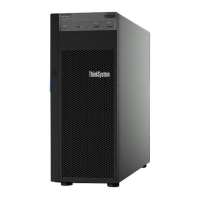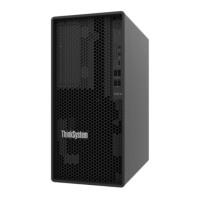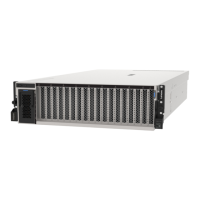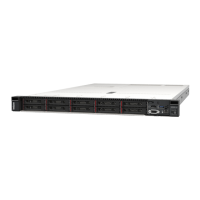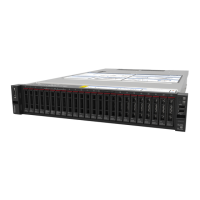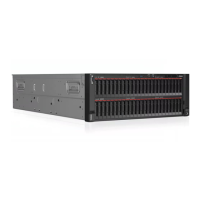You can use the config application and commands to view the current system configuration settings and
make changes to Lenovo XClarity Controller and UEFI. The saved configuration information can be used
to replicate or restore other systems.
For information about configuring the server using Lenovo XClarity Essentials OneCLI, see:
http://sysmgt.lenovofiles.com/help/topic/toolsctr_cli_lenovo/onecli_c_settings_info_commands.html
• Lenovo XClarity Administrator
You can quickly provision and pre-provision all of your servers using a consistent configuration.
Configuration settings (such as local storage, I/O adapters, boot settings, firmware, ports, and Lenovo
XClarity Controller and UEFI settings) are saved as a server pattern that can be applied to one or more
managed servers. When the server patterns are updated, the changes are automatically deployed to the
applied servers.
Specific details about updating firmware using Lenovo XClarity Administrator are available at:
http://sysmgt.lenovofiles.com/help/topic/com.lenovo.lxca.doc/server_configuring.html
• Lenovo XClarity Controller
You can configure the management processor for the server through the Lenovo XClarity Controller Web
interface or through the command-line interface.
For information about configuring the server using Lenovo XClarity Controller, see:
“Configuring the Server” section in the XCC documentation compatible with your server at
https://
sysmgt.lenovofiles.com/help/topic/lxcc_frontend/lxcc_overview.html
Memory configuration
Memory performance depends on several variables, such as memory mode, memory speed, memory ranks,
memory population and processor.
More information about optimizing memory performance and configuring memory is available at the Lenovo
Press website:
https://lenovopress.com/servers/options/memory
In addition, you can take advantage of a memory configurator, which is available at the following site:
http://1config.lenovo.com/#/memory_configuration
For specific information about the required installation order of memory modules in your server based on the
system configuration and memory mode that you are implementing, see
the ThinkSystem ST250 V2 Memory
Population Reference
.
RAID configuration
Using a Redundant Array of Independent Disks (RAID) to store data remains one of the most common and
cost-efficient methods to increase server's storage performance, availability, and capacity.
RAID increases performance by allowing multiple drives to process I/O requests simultaneously. RAID can
also prevent data loss in case of a drive failure by reconstructing (or rebuilding) the missing data from the
failed drive using the data from the remaining drives.
RAID array (also known as RAID drive group) is a group of multiple physical drives that uses a certain
common method to distribute data across the drives. A virtual drive (also known as virtual disk or logical
Chapter 4. System configuration 113

